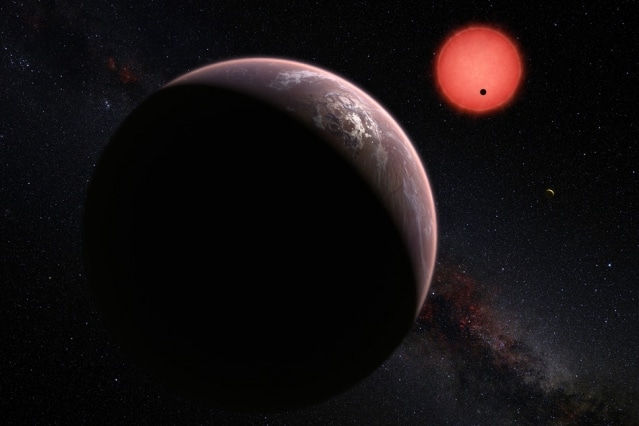May 4 2016
A group of astronomers at MIT, the University of Liège in Belgium, and elsewhere have discovered three Earth-like exoplanets orbiting around an ultracool dwarf star for the first time. They are located just 40 light years from our planet. Their sizes and temperatures are similar to those of Earth and Venus, making them the best targets ever found in search of life beyond our solar system.
 This artist’s rendering shows an imagined view of the three planets orbiting an ultracool dwarf star just 40 light-years from Earth that were discovered using the TRAPPIST telescope at ESO’s La Silla Observatory. In this view, one of the inner planets is seen in transit across the disc of its tiny and dim parent star. (Image: M. Kornmesser/ESO)
This artist’s rendering shows an imagined view of the three planets orbiting an ultracool dwarf star just 40 light-years from Earth that were discovered using the TRAPPIST telescope at ESO’s La Silla Observatory. In this view, one of the inner planets is seen in transit across the disc of its tiny and dim parent star. (Image: M. Kornmesser/ESO)
The study results have been reported in the Nature journal.
The 60 cm TRAnsiting Planets and PlanetesImals Small Telescope (TRAPPIST) operated by the University of Liège, located in Chile, was used in the discovery of the exoplanets. This telescope is devised to focus on 60 small, cool, nearby dwarf stars, which cannot be detected by optical telescopes. It was designed by Belgian scientists to detect the planets orbiting around these dwarf stars by monitoring the stars at infrared wavelengths.
Using this telescope, the astronomers discovered the ultracool dwarf star, dubbed 2MASS J23062928-0502285 or TRAPPIST-1. The Jupiter-sized star is nearly one-eighth of our sun’s size but considerably cooler. The mission of monitoring the dwarf star started in September 2015 for several months. During this period, the team observed weakening of the infrared signal of the star at regular intervals, indicating the passage of several objects in front of the dwarf star.
Further observations by the researchers corfirmed that the objects were actually Earth- and Venus-sized planets. The orbital duration of the two innermost planets is 1.5 and 2.4 days. However, the amount of radiation received by these planets is only four and two times, respectively, when compared to the amount of radiation received by the Earth from the sun. The orbital duration of the third planet may vary between 4 and 73 days, receiving even less radiation compared to Earth. Considering the size and proximity to the dwarf star, regions with temperatures less than 400 K may be present in all of these planets. This range is ideal for life and liquid water.
Since the planetary system is located at a distance of just 40 light years from our planet, co-author Julien de Wit, a postdoc in the Department of Earth, Atmospheric, and Planetary Sciences, anticipates that researchers will soon be able to explore the atmospheric compositions and the habitability of the planets, and discover if life exists within this system.
These planets are so close, and their star so small, we can study their atmosphere and composition, and further down the road, which is within our generation, assess if they are actually inhabited. All of these things are achievable, and within reach now. This is a jackpot for the field.
Julien de Wit, Postdoc, Department of Earth, Atmospheric, and Planetary Sciences, MIT
Most of the ongoing exoplanetary missions are exploring planetary systems orbiting bright, sun-like stars. Optical telescopes can detect these stars as their radiation is in the visible region, most frequently at yellow wavelengths. However, it is not possible to detect any signal emitted by a planet of these stars due to their high brightness.
Conversely, the radiation emitted by the cold dwarf stars or faint stars is in the infrared region, enabling scientists to detect any signal emitted by the planetary systems orbiting these tiny red stars. Although most of today’s missions do not give focus to such stars.
That means they can’t detect planets around such stars. So you have to design a completely different survey using special instruments and detectors — it’s a risk.
Julien de Wit, Postdoc, Department of Earth, Atmospheric, and Planetary Sciences, MIT
This risk was taken by lead authors Michael Gillon and Emmanuel Jehin, of the University of Liège, and consequently, TRAPPIST was built as a proof-of-concept telescope that is capable of focusing on 60 small, nearby dwarf stars.
It’s not looking at 100,000 stars at a time, like the Kepler Space Telescope. It’s a few of them that you’re spending time on, one at a time. And one paid off.
Julien de Wit, Postdoc, Department of Earth, Atmospheric, and Planetary Sciences, MIT
The researchers observed that the planets are potentially tidally locked with everlasting day and night sides. The two planetary systems orbiting closest to the dwarf star may have too cold night sides and too hot day sides, which are unsuitable for sustaining any life forms. Nevertheless, the western side of both planets may have a “sweet spot” that receives daylight with comparatively cool temperatures, which may be suitable for sustaining life. The third planet may be completely within the habitable region as it is furthest from the dwarf star.
Going forward, the objective is very clear, said de Wit.
Now we have to investigate if they’re habitable. We will investigate what kind of atmosphere they have, and then will search for biomarkers and signs of life. We have facilities all over the globe and in space that are helping us, working from UV to radio, in all different wavelengths to tell us everything we want to know about this system. So many people will get to play with this [system].
Julien de Wit, Postdoc, Department of Earth, Atmospheric, and Planetary Sciences, MIT
The Belgian Fund for Scientific Research, the European Research Council, and NASA partially funded the research work.